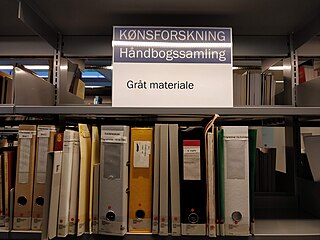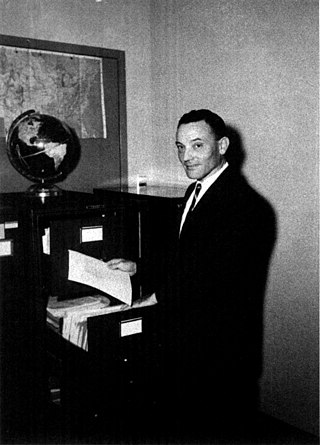
The United States Atomic Energy Commission (AEC) was an agency of the United States government established after World War II by the U.S. Congress to foster and control the peacetime development of atomic science and technology. President Harry S. Truman signed the McMahon/Atomic Energy Act on August 1, 1946, transferring the control of atomic energy from military to civilian hands, effective on January 1, 1947. This shift gave the members of the AEC complete control of the plants, laboratories, equipment, and personnel assembled during the war to produce the atomic bomb.

The United States Department of Energy (DOE) is an executive department of the U.S. federal government that oversees U.S. national energy policy and energy production, the research and development of nuclear power, the military's nuclear weapons program, nuclear reactor production for the United States Navy, energy-related research, and energy conservation.

Pacific Northwest National Laboratory (PNNL) is one of the United States Department of Energy national laboratories, managed by the Department of Energy's (DOE) Office of Science. The main campus of the laboratory is in Richland, Washington.

The Nuclear Regulatory Commission (NRC) is an independent agency of the United States government tasked with protecting public health and safety related to nuclear energy. Established by the Energy Reorganization Act of 1974, the NRC began operations on January 19, 1975, as one of two successor agencies to the United States Atomic Energy Commission. Its functions include overseeing reactor safety and security, administering reactor licensing and renewal, licensing radioactive materials, radionuclide safety, and managing the storage, security, recycling, and disposal of spent fuel.

The Federal Depository Library Program (FDLP) is a government program created to make U.S. federal government publications available to the public at no cost. As of April 2021, there are 1,114 depository libraries in the United States and its territories. A "government publication" is defined in the U.S. Code as "informational matter which is published as an individual document at Government expense, or as required by law".

Idaho National Laboratory (INL) is one of the national laboratories of the United States Department of Energy and is managed by the Battelle Energy Alliance. Historically, the lab has been involved with nuclear research, although the laboratory does other research as well. Much of current knowledge about how nuclear reactors behave and misbehave was discovered at what is now Idaho National Laboratory. John Grossenbacher, former INL director, said, "The history of nuclear energy for peaceful application has principally been written in Idaho".

The Office of Scientific and Technical Information (OSTI) is a component of the Office of Science within the U.S. Department of Energy (DOE). The Energy Policy Act PL 109–58, Section 982, called out the responsibility of OSTI: "The Secretary, through the Office of Scientific and Technical Information, shall maintain with the Department publicly available collections of scientific and technical information resulting from research, development, demonstration, and commercial applications activities supported by the Department."

Naval Reactors (NR), which administers the Naval Nuclear Propulsion Program, is an umbrella term for the U.S. government office that has comprehensive responsibility for the safe and reliable operation of the United States Navy's nuclear reactors "from womb to tomb." A single entity, it has authority and reporting responsibilities within both the Naval Sea Systems Command and the National Nuclear Security Administration (NA-30). Moreover, the Director of Naval Reactors also serves as a special assistant to the Chief of Naval Operations for Naval Nuclear Propulsion.

Grey literature is materials and research produced by organizations outside of the traditional commercial or academic publishing and distribution channels. Common grey literature publication types include reports, working papers, government documents, white papers and evaluations. Organizations that produce grey literature include government departments and agencies, civil society or non-governmental organizations, academic centres and departments, and private companies and consultants.

Richard Greening Hewlett was an American public historian best known for his work as the Chief Historian of the United States Atomic Energy Commission.
Keeve Milton (Kip) Siegel was an American physicist. He was a professor of electrical engineering at the University of Michigan in Ann Arbor, MI, and the founder of Conductron Corporation, a high-tech producer of electronic equipment which was absorbed by McDonnell Douglas Corporation; KMS Industries and KMS Fusion. KMS Fusion was the first private sector company to pursue controlled thermonuclear fusion energy production through use of laser technology.

The United States Energy Research and Development Administration (ERDA) was a United States government organization formed from the split of the Atomic Energy Commission (AEC) in 1975. It assumed the functions of the AEC not assumed by the Nuclear Regulatory Commission.
CENDI is an interagency group of senior Scientific and Technical Information (STI) managers from 14 United States federal agencies. CENDI managers cooperate by exchanging information and ideas, collaborating to address common issues, and undertaking joint initiatives. CENDI's accomplishments range from impacting federal information policy to educating a broad spectrum of stakeholders on all aspects of federal STI systems, including its value to research and the taxpayer, and to operational improvements in agency and interagency STI operations.
The Office of Science is a component of the United States Department of Energy (DOE). The Office of Science is the lead federal agency supporting fundamental scientific research for energy and the Nation’s largest supporter of basic research in the physical sciences. The Office of Science portfolio has two principal thrusts: direct support of scientific research and direct support of the development, construction, and operation of unique, open-access scientific user facilities that are made available for use by external researchers.

Since the discovery of ionizing radiation, a number of human radiation experiments have been performed to understand the effects of ionizing radiation and radioactive contamination on the human body, specifically with the element plutonium.
The Energy Science and Technology Database (EDB) is a multidisciplinary file containing worldwide references to basic and applied scientific and technical research literature. The information is collected for use by government managers, researchers at the national laboratories, and other research efforts sponsored by the U.S. Department of Energy, and the results of this research are transferred to the public. Abstracts are included for records from 1976 to the present day.

The Energy Technology Data Exchange (ETDE) was formed in 1987 and officially ended 30 June 2014. It was initiated as a multilateral agreement under the International Energy Agency (IEA) agreement network, replacing numerous other bilateral agreements. The multilateral agreement was for the international exchange of energy research and development and information. The exchange resulted in a database which was the world's largest collection of energy research, technology, and development (RTD) information. The collection of information was generated from energy RTD literature published in member countries and through other partnering arrangements with organizations such as the International Nuclear Information System. This had the effect of creating a broad spectrum of information that was included in the ETDE database. The range of content included fossil fuels, renewable energies, End-Use, fusion, energy policy, conservation, and efficiency, and cross-sectional activities. This fulfilled the need for timely exchange of global information towards the goal of a sustainable energy future. ETDE operated under an IEA Implementing Agreement and was governed by an Executive Committee of delegates from ETDE member countries. Officers of the Executive Committee included a Chair and two Vice-Chairs, elected to three-year terms. Day-to-day operations were managed through an operating agent organization, which reported to the Executive Committee.
Science Accelerator was a web-based gateway to science information including research results from the U.S. Department of Energy (DOE). The information was provided as a free public service by the DOE Office of Scientific and Technical Information (OSTI), within the Office of Science. It used federated search technology to search DOE-generated and DOE-related science information databases and collections. Federated search technology allowed the user to search multiple data sources with a single query in real time. It provided simultaneous access to "deep web" scientific databases, which were typically not searchable by commercial search engines.
The Information Bridge: Department of Energy Scientific and Technical Information database provides free public access to over 298,000 full-text electronic documents of Department of Energy (DOE) research report literature. See list of academic databases and search engines.

Stephen O. Dean is an American physicist, engineer and author. He was born in Niagara Falls, New York, United States, and grew up there through high school.














